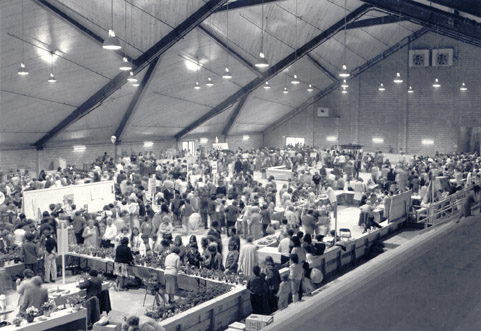How to sell your handcrafts at a craft show
People get into crafting because they love creating things. Sometimes they realize they could sell the same stuff that they’ve been making for people they know, to people they don’t know. If you make handcrafts, and you think that you’d like to sell them at a craft show, the tips and suggestions in this article are definitely for you. There are a number of factors to take into consideration when you want to sell your unique and personal creations. Follow these guidelines to start making extra money from selling your handcrafts at a craft show.

Things you’ll need
- business plan
- expense budget
- tax accountant
- business management software
- business cards
- advertising flyers and handouts
- table and chairs
- booth risers and displays
- decorations
- table cloths and skirting
- signs

Procedure Steps
- When considering a crafting business, there are some common mistakes that can stop your small business before it even starts. First among these is when the seller prices their product too low in hopes of selling it quicker and thus insuring success. Unfortunately, this has a backwards effect on your business. You end up working yourself to the bone to sell your product for just a small profit and saturate the market with your work. You should not only make sure your pricing includes your materials, but there are other factors to work in as well, like marketing and your personal labor.
- You should have a solid business plan to refer to at all times. You don’t need to hire a professional business planner, all you need is to have a well-thought out strategy as to how and where you’ll be selling your crafts. Think about what shows you want to attend and the costs associated with being at those shows. Look at your original business plan often and make changes according to your needs. You may hit on an amazing product that sells like wildfire, and you’ll have to adapt to meet your customers.
- A budget is a simple way for you to control your anticipated expenses. At the end of each month, plan next month’s budget based on your performance. Start with minimum expenses, which are things you must have to function like show fees, supplies, etc. Then work your way down the list to things you would like to do if you make enough money. When planning your budget, be sure to allow for savings that will get you through the lean times—and there will be some lean times. It’s best to keep 3 to 6 months of operating expenses in savings.
- A normal marketing plan would include advertising in the local newspapers or on radio stations. But, because of the nature of craft shows, doing advertising like this probably won’t help you. Consider some of these overlooked opportunities for you to market your products at little or no expense: Home Parties or Private Showings, Holiday House Boutiques (special craft shows ordinarily offered twice a year—Christmas and spring), Catalogs, Internet Stores, Schools, Work Place (yours or a friend’s), Small Businesses (if you have a product that fits a certain business niche, concentrate on those places), Hospital Gift Shops (these are very profitable if you have a craft that could be used for baby gifts, get well gifts, and baskets filled with items like magazines, crossword puzzles, and ways to pass the time).
- Always include your web address and all pertinent contact information on any business cards, flyers, or other advertising that you might do. Use your personal computer and print up a simple one or two page flyer with a few pictures of your products along with pricing information and the story behind you and your crafts. Include a part on the flier that offers a discount (such as free shipping or 10 percent off purchase) when the flier is mentioned. Make your fliers available at your booth for the craft show, and don’t hesitate to hand them out every chance you get. Be creative and make them eye-catching and interesting. If you find yourself with a small mail order business, put fliers in all packages that you send out.
- Print up business cards and give them to everyone you see. This can be the most profitable way for you to show people you are serious about your business and draw them to your website (if you have one). Attach a business card to every single item you produce. While cards printed up professionally will look better, you can still use your home computer and printer to create business cards that express the essence of you and your crafts. You can buy pre-cut cards at any office supply store.
- Of course, nothing can guarantee finding a great craft show for you to sell your handcrafts. Different products sell better at different types of events. Figure out where your product niche is and go for the shows that best fit your needs. Crafting magazines list hundreds of opportunities to attend events. Also, search the Internet for shows that fit your crafts. Ask people who attend craft fairs which ones they like the best. Ask other crafters which shows they like. Call your local Chambers of Commerce to see if there are any craft fairs in your area. Ask if they’ll be sponsoring any events where crafts are sold. Also, check with local area craft stores, they will most likely know about an event happening close by that you can attend.
- Your booth space is your storefront at the craft show. You want to convey an inviting, professional, and attractive look. If you have the space, it’s a good idea to set up your display cases or tables in an “L” shape, where people can have a sense of walking into your temporary store. Decide whether or not you want everything on a table or if you want to give your display some height. Don’t make it boring by just throwing some items on a table and sitting back to collect the money.
- There are so many ways to add height to your display. You can buy plastic take-apart shelves that will look good and be easy to carry. Another way is to have a small peg board made to fit on the ends of the table. You can even take the boxes that you carry your items in and place them on the table to make a riser, then cover them with fabric. Whatever you use you will want to make it safe so that it will not fall over onto your customer.
- Be sure your table set up is how you want it before going to the show. Try a practice set up at home to get an idea of how much space you’ll need. After you have your table set up the way that you think you want it, leave the room for awhile. Now come back in with a fresh view and think of yourself as the customer. How does your space look to you now? Are you happy with your idea or is it lacking something?
- Part of your booth planning should include a credit card machine. Credit cards are the common currency of shows and fairs, and if you don't accept them, you're going to lose sales to vendors who do. You also face the risks of dealing with bounced checks from strangers who may be hard to track down after the show. Especially if you're selling work priced in the hundreds of dollars, credit cards are a must.
- Try putting a fishbowl on your table and offering people a chance to win something in return for giving you their contact information or business cards. Not only does this drive traffic to your booth, but it helps you build your mailing list. This way, you can send out postcards inviting prospects to your next show or providing them with a catalog or link to your website.
- If you will be outside and need a tent, you can get a great 10’ x 10’ or similar sized tent for a reasonable price at many discount stores or online. These tents pack up into a very manageable bundle. Determine how well the tent will perform in wet weather and in high winds. Determine if you can hang things from the tent’s frame, or if you will need to set up separate display panels. Be sure you practice setting up and taking down the tent prior to the show. Determine if it will take one person or more to do this.
- Be sure you have a clear, prominent sign that includes the name of your business and location along with a phone number and website. If your booths are numbered, this number should appear on the sign too. Use colors, typefaces, and images on your sign which have the same feel as your merchandise. Don’t overdo your signage, so that the signs overwhelm your inventory.

Tips
- You can generally create fliers quite cheaply on your own printer, but you can also get some good results by going to a discount office supply store.
- Be wary of attending the wrong types of craft shows, especially if your craft is fine art. Fine crafts and artwork belong at shows where customers can appreciate the work involved. But that type of art show is not a street fair; it’s more a showcase for professional artists.
- Most craft shows will want you to look professional and cover your table down to the floor and all the way around. You can buy professional covers made for your table, called “skirting,” or you can buy an attractive, inexpensive fabric to cover your table with.
- Don’t over-fill your booth. Too many items are distracting to potential customers.
- Don’t forget you’ll need plastic bags on hand for you to put your customers’ purchases in when they leave.
- Collect e-mail addresses from everyone at the craft show. It's a lot cheaper to send out 100 e-mail messages than it is to pay for paper and postage.
Warnings
- Be careful of following trends. Too often, new crafters will see a fellow crafter sell their product like wildfire and think that they should follow suit with the same product at a different show. Never change your product line completely to follow the crowd.
- When accepting checks, be sure to get the person's Driver's License number and their phone number. Verify that the preprinted address on the check is the current address. Don't accept starter checks—those checks people get when they open a bank account, and which don't have a preprinted address or phone information on them. You are a business, and you owe it to yourself to be cautious even if a person gets upset with you.
- Having a business means you will have to pay taxes. One of the reasons for small business failure is poor tax planning. It’s always best to have an accountant, but you can use a money management software program to do your taxes. Keep any tax savings in a separate business checking account for easy transfer.
What did you think of this tutorial?
+ 1
0 CommentsAdd a Comment




